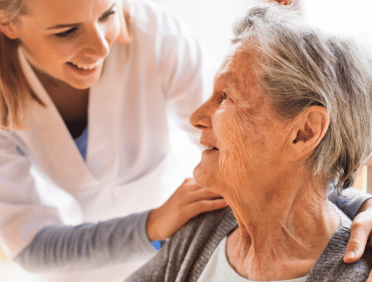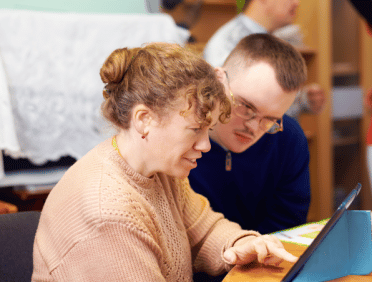Safeguarding Adults at Risk: Domestic Violence
Domestic abuse (intimate partner violence or family violence) is a pattern of incidents of controlling, coercive, degrading, threatening, and violent behavior. It can occur between people who are, or have been, intimate partners or family members. Domestic abuse can happen to anyone, regardless of gender, age, ethnicity, or sexual orientation. It is a violation of human rights and can have serious physical and emotional consequences for victims.
In this blog, we will explore the safeguarding adults at risk of abuse policy, who should be involved in safeguarding adults who may be at risk, the role of individuals in safeguarding adults at risk, the Care Act 2014 (safeguarding adults), and how to recognise domestic violence. We will also discuss the importance of safeguarding adults at risk training.
What is the safeguarding adults at risk of abuse policy?
Safeguarding adults at risk of abuse is a set of policies and procedures designed to protect adults who may be at risk of abuse or neglect. It is a legal duty under the Care Act 2014 for local authorities and other agencies to work together to prevent, identify, and respond to adult abuse.
The policy aims to ensure that adults at risk of abuse are protected from harm and that they are supported to live safely and independently. It involves working with the individual, their family and carers, and other agencies to identify any risks, take action to prevent abuse, and respond appropriately if abuse occurs.
Who should be involved in safeguarding adults who may be at risk?
Everyone has a responsibility to safeguard adults who may be at risk of abuse. This includes individuals, families, friends, carers, and professionals such as healthcare workers, social workers, police officers, and other professionals who work with vulnerable adults.
When safeguarding adults who may be at risk, it is essential to work collaboratively and share information appropriately to ensure the best possible outcomes for the individual.
What is my role in safeguarding adults at risk?
As an individual, your role in safeguarding adults at risk is to be aware of the signs and indicators of abuse and to report any concerns to the appropriate authorities. You should also be aware of your own behavior and how it may impact vulnerable adults.
If you are a family member or carer, it is essential to provide support and care in a way that respects the dignity and rights of the individual. You should also report any concerns about abuse or neglect to the appropriate authorities.
If you are a professional who works with vulnerable adults, your role is to ensure that you are aware of and follow the relevant policies and procedures for safeguarding adults at risk. This includes reporting any concerns, sharing information appropriately, and working collaboratively with other agencies to ensure the best possible outcomes for the individual.
The Care Act 2014 (safeguarding adults)
The Care Act 2014 outlines the legal framework for safeguarding adults at risk of abuse in England. It sets out the responsibilities of local authorities and other agencies to protect adults who may be at risk of abuse or neglect.
The Act places a duty on local authorities to make inquiries if they believe that an adult with care and support needs may be at risk of abuse or neglect. It also requires local authorities to work collaboratively with other agencies to prevent, identify, and respond to adult abuse.
The Care Act 2014 places a strong emphasis on prevention and early intervention, recognising that prevention is better than cure. It also emphasises the importance of promoting the individual’s rights and independence and ensuring that they are involved in decisions that affect their lives.
Recognising Domestic Violence
Domestic violence is a form of abuse that can take many forms. It can be physical, emotional, financial, or sexual. It can also include coercive control, which is a pattern of behavior that seeks to take away the victim’s freedom and independence.
Emotional abuse
Emotional abuse is a form of abuse that involves using words, actions, or behaviors to control, manipulate, or intimidate the victim. Emotional abuse can be difficult to recognise, but it can cause significant emotional harm to the victim.
Examples of emotional abuse in the context of domestic violence can include verbal insults, threats, or humiliation, controlling or monitoring the victim’s behavior or whereabouts, isolating the victim from friends and family, and manipulating the victim’s emotions to make them feel guilty or ashamed.
Emotional abuse can have long-term effects on the victim’s mental health and well-being, including depression, anxiety, low self-esteem, and post-traumatic stress disorder (PTSD). It can also make it difficult for the victim to leave the abusive relationship, as they may feel trapped or powerless.
It is important to recognise that emotional abuse is a form of domestic violence and is not acceptable under any circumstances. Victims of emotional abuse should be provided with support and resources to address their experience. It is also essential to report incidents of emotional abuse to the appropriate authorities, such as the police or social services, so that they can investigate and take appropriate action to protect the victim and prevent future occurrences.
Financial
Financial abuse is a form of abuse that involves controlling or exploiting the victim’s financial resources. Financial abuse can be subtle and difficult to recognise, but it can have significant long-term effects on the victim’s financial security and well-being.
Examples of financial abuse in the context of domestic violence can include restricting access to money or financial resources, forcing the victim to hand over control of their finances, stealing money or possessions, or preventing the victim from working or pursuing education.
Financial abuse can leave the victim feeling trapped, helpless, and dependent on their abuser. It can also make it difficult for the victim to leave the abusive relationship, as they may not have the financial resources to do so.
It is important to recognise that financial abuse is a form of domestic violence and is not acceptable under any circumstances. Victims of financial abuse should be provided with support and resources to address their experience. It is also essential to report incidents of financial abuse to the appropriate authorities, such as the police or social services, so that they can investigate and take appropriate action to protect the victim and prevent future occurrences.
Honour-based violence
A form of abuse that is based on the belief that a person has brought shame or dishonor to their family or community. Honour-based violence can take many forms, including forced marriage, female genital mutilation, or other forms of violence that are justified by the notion of “honour.”
Honour-based violence can involve family members or members of the community and can be difficult to detect or report, as the victim may be pressured to keep the abuse a secret or may fear retribution if they speak out.
Honour-based violence can cause significant physical and emotional harm to the victim, including physical injuries, trauma, depression, and anxiety. It can also result in the victim being isolated from their family and community, which can make it difficult for them to seek help or support.
It is important to recognise that honour-based violence is a form of domestic violence and is not acceptable under any circumstances. Victims of honour-based violence should be provided with support and resources to address their experience. It is also essential to report incidents of honour-based violence to the appropriate authorities, such as the police or social services, so that they can investigate and take appropriate action to protect the victim and prevent future occurrences.
Physical
Involves using physical force to cause harm or injury to the victim. Physical abuse can take many forms, including hitting, punching, slapping, kicking, or other forms of physical assault.
Physical abuse can cause significant physical and emotional harm to the victim, including physical injuries, trauma, and anxiety. It can also result in the victim feeling scared, trapped, or powerless.
Physical abuse can be difficult to recognise, especially if the victim tries to hide the abuse or make excuses for the abuser’s behavior. However, signs of physical abuse may include unexplained bruises or injuries, frequent injuries or accidents, or a history of injuries that do not match the explanation given.
It is important to recognise that physical abuse is a form of domestic violence and is not acceptable under any circumstances. Victims of physical abuse should be provided with support and resources to address their experience. It is also essential to report incidents of physical abuse to the appropriate authorities, such as the police or social services, so that they can investigate and take appropriate action to protect the victim and prevent future occurrences.
Psychological
Psychological abuse is a form of abuse that involves using psychological tactics to control, manipulate, or intimidate the victim. Psychological abuse can take many forms, including gaslighting, mind games, or other forms of psychological manipulation.
Psychological abuse can cause significant emotional harm to the victim, including depression, anxiety, low self-esteem, and post-traumatic stress disorder (PTSD). It can also result in the victim feeling trapped, isolated, or powerless.
Psychological abuse can be difficult to recognise, as the effects are often not visible. However, signs of psychological abuse may include changes in the victim’s behavior or personality, such as increased anxiety, withdrawal from social activities, or a lack of confidence or self-esteem.
It is important to recognise that psychological abuse is a form of domestic violence and is not acceptable under any circumstances. Victims of psychological abuse should be provided with support and resources to address their experience. It is also essential to report incidents of psychological abuse to the appropriate authorities, such as the police or social services, so that they can investigate and take appropriate action to protect the victim and prevent future occurrences.
Sexual
Sexual abuse is a form of abuse that involves any unwanted sexual activity, including rape, sexual assault, or unwanted touching. It can also include using sex as a weapon, such as withholding sex or forcing the victim to engage in sexual activity against their will.
Sexual abuse can cause significant physical and emotional harm to the victim, including physical injuries, trauma, depression, and anxiety. It can also result in the victim feeling scared, trapped, or powerless.
Sexual abuse can be difficult to recognise, especially if the victim tries to hide the abuse or make excuses for the abuser’s behavior. However, signs of sexual abuse may include unexplained injuries or bruises, a history of sexual trauma, or changes in the victim’s behavior or personality, such as increased anxiety or withdrawal from social activities.
It is important to recognise that sexual abuse is a form of domestic violence and is not acceptable under any circumstances. Victims of sexual abuse should be provided with support and resources to address their experience. It is also essential to report incidents of sexual abuse to the appropriate authorities, such as the police or social services, so that they can investigate and take appropriate action to protect the victim and prevent future occurrences.
Safeguarding of Adults Training
- Learn Q’s Safeguarding Adults Level 1 is an introductory course that provides a basic understanding of safeguarding vulnerable adults. It covers the concept of safeguarding, the importance of safeguarding, the legislation in place to protect vulnerable adults, the signs of abuse and how to avoid them, and how to respond when a vulnerable adult discloses they are being abused or neglected. This course is suitable for anyone who works with vulnerable adults, including managers, supervisors, employees, and volunteers at all levels.
- Learn Q’s Safeguarding Adults Level 2 course, on the other hand, is a more advanced course that builds on the knowledge gained in Level 1. It provides a more in-depth understanding of safeguarding, including recognising abuse, the responsibilities of different safeguarding roles, effective communication, and how to handle concerns and incidents related to safeguarding. This course is designed for those with additional safeguarding responsibilities, such as those who work in hospitals, general practices, nursing homes, care homes, or domiciliary care, as well as in religious organisations and community organisations.
Overall, while both courses cover the essential knowledge and skills needed to safeguard vulnerable adults, Safeguarding Adults Level 2 provides a more comprehensive and detailed understanding of safeguarding, which is important for those who have additional safeguarding responsibilities.
These courses are ideal for those who work in hospitals, general practices, nursing homes, care homes, domiciliary care, as well as in religious and community organisations. By completing this course, you will be better equipped to handle safeguarding concerns and to ensure the safety and well-being of vulnerable adults.
At Learn Q, we are committed to providing high-quality training that meets the needs of professionals across a range of industries. Our Safeguarding Adults courses are designed to provide you with the knowledge and skills you need to excel in your role and make a real difference in the lives of vulnerable adults. Sign up today and take the next step in your career!
In conclusion, domestic violence is a form of abuse that can have serious physical and emotional consequences for its victims. Safeguarding adults at risk of abuse is essential to protect vulnerable adults and ensure their safety and well-being. It is everyone’s responsibility to be aware of the signs and indicators of abuse and to report any concerns to the appropriate authorities. Safeguarding adults training is essential to ensure that individuals are equipped to deal with the complexities of safeguarding adults at risk. By working collaboratively and sharing information appropriately, we can create a safer environment for vulnerable adults and prevent abuse from occurring.
To download a .pdf of this blog, please click here












